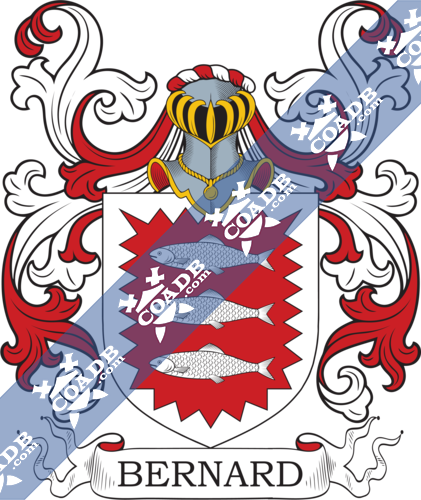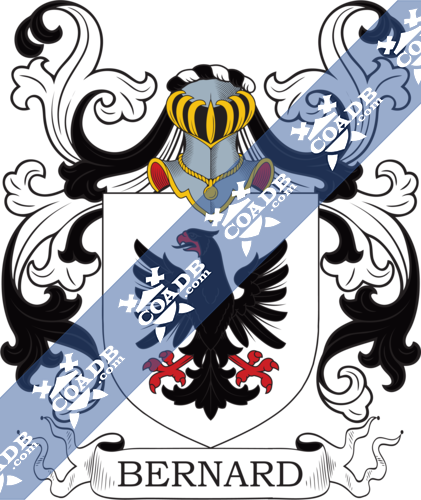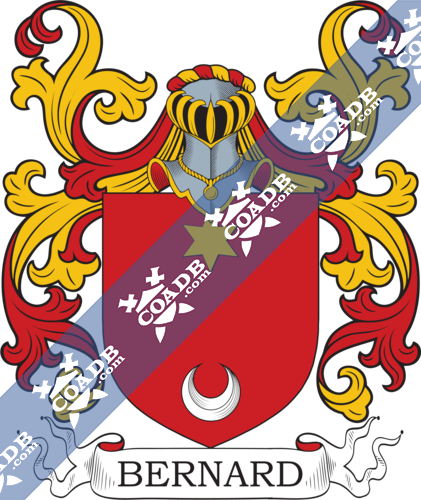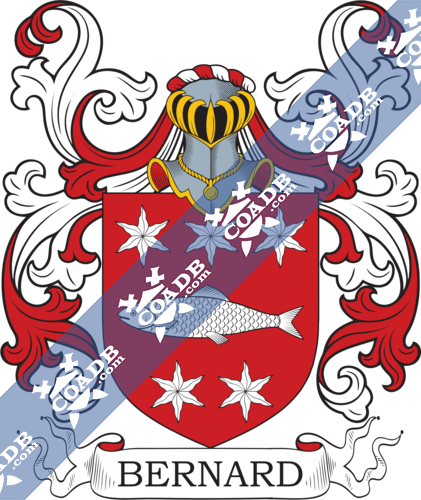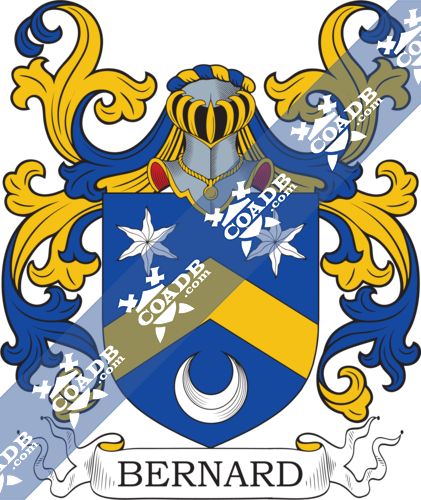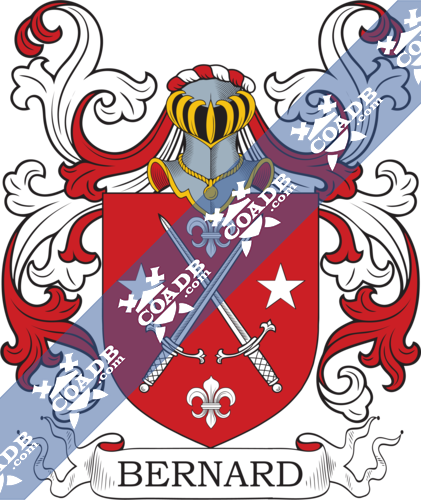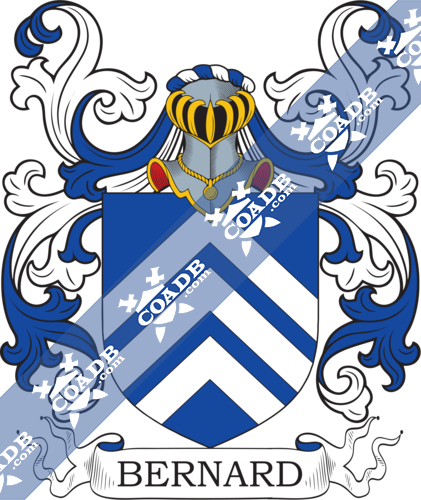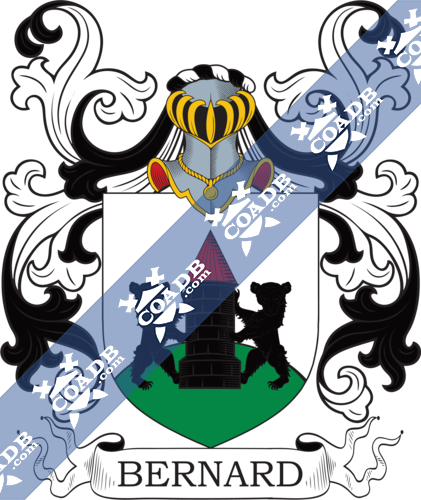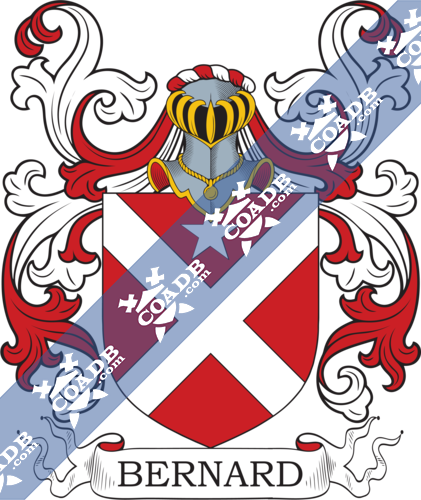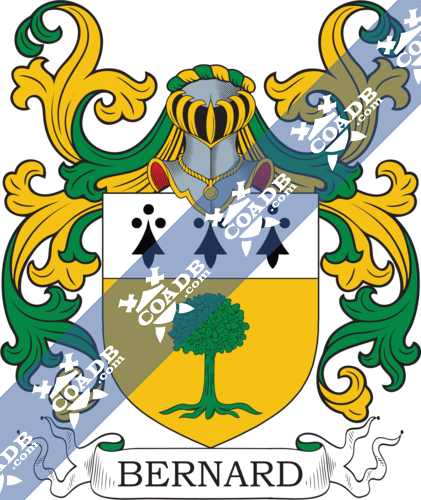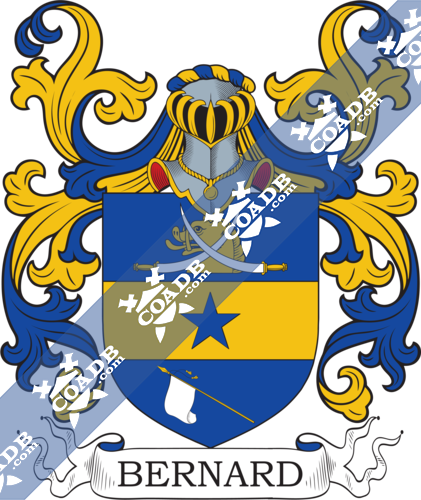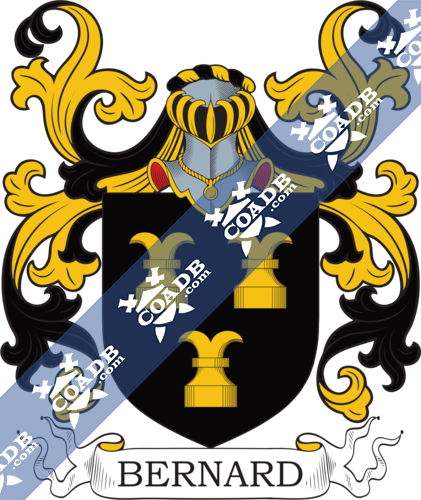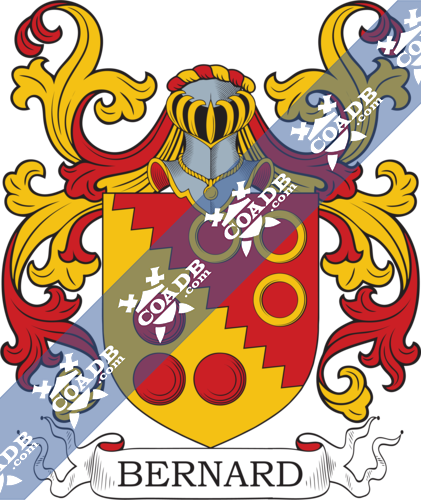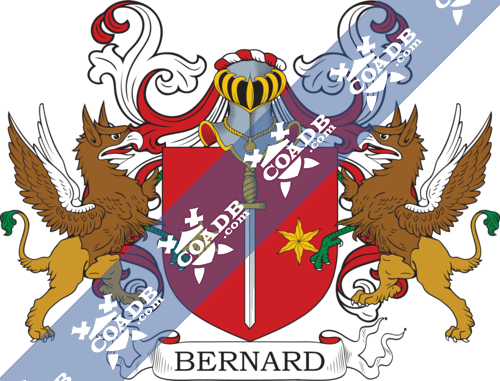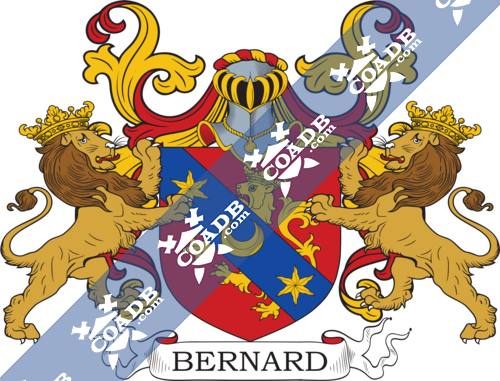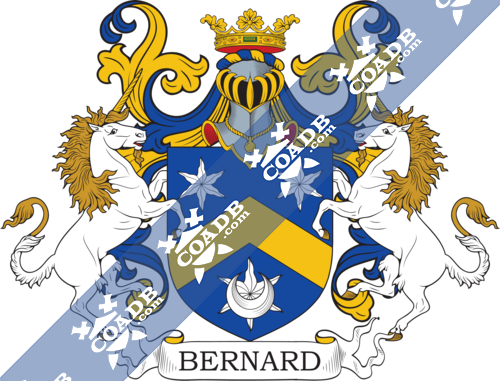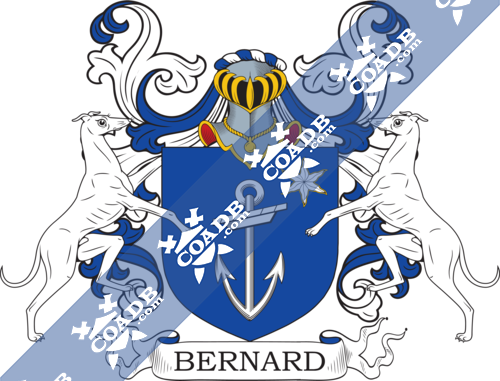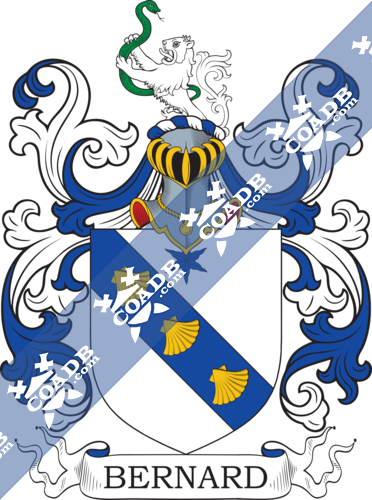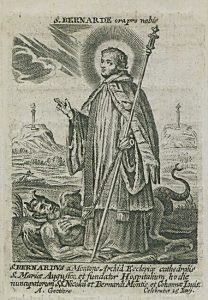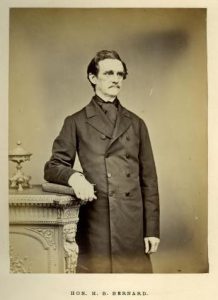Bernard Family Crest, Coat of Arms and Name History

Bernard Coat of Arms Gallery
Don’t know which Coat of Arms is yours?
We can do a genealogical research. Find out the exact history of your family!
Learn MoreSurname Name Meaning, Origin, and Etymology
This is a well-known European surname, that traces back to at least the 400s AD, derives from the old Germanic personal (first) name Bernhard or Bernard that was popularized due to the fact that it was the borne by St. Beranrd of Clairvaux (1090-1143) who was the founder of the Cistercian monastery. There was also another well-known Catholic saint bearing this personal name: St. Bernard Menthon (923-1108 AD) who founded Alpine hospices. Bernard is a masculine given name that is likely of West Germanic origin and was particulary popular among Old Frisian speakers.
The name is French, English, Dutch, Poland, Czech, and Slovenian. It is a baptismal surname meaning “the son of Bernard”. It derives from the words bearn or bairn (child) and the Teutonic word ard (nature or disposition). Hence the name literally translates to a person with a child-like disposition. Another source states it derives from the word beorn (heart), meaning one of stout heart. Another source claims the root word bern means bear and hard means hardy, brave, or strong.
Spelling Variations
Common spelling variants and names with similar etymological origins include, but are not limited to, the following: Bernards, Barbard, Bernardson, Barnett, Berners, Bernhardt, Bernucci, Bietatowicz, Benthy, Bernat, Burnard, Bernarde, and Bairnard.
Popularity & Geographic Distribution
The last name ranks Bernard ranks 864th in popularity in terms in the United Status as of the 2000 Census. The name is particularly common in Louisiana, Maine, and New Hampshire. The name is much more common in France, where it ranks 3rd in terms of popularity. The last name Bernard ranks 188th in Canada, 1,557th in England (most common is Lancashire), and 1,151th in Germany.
Early Bearers of the Surname
The earliest known bearer was Hugo Bernard who was documented in the Pipe Rolls of Lincoln, England in 1130 AD. A one Walter filius Bernardi was recorded in the Pipe Tolls, or Sheriffs’ Annual Accounts for the Counties of Cumberland, Westmoreland, and Durham in 1214 AD. The Hundred Rolls of 1273 AD, a census of Wales and England, known in Latin as Rotuli Hundredorum, documents two people bearing this surname: Walter filius Bernard and Beranrd Coronator. A one Thomas Bernhard was recorded in 1260 AD in Cambridge, England. The Register of The University of Oxford in 1581 records one Abel Bernardi in county Oxford. In 1595, the same register records one Benjamin Bernarde (or Barnarde) in London. An early marriage involving this surname was Francis Bernard to Sara Bleamire in 1753 at St. George’s Chapel Mayfair. The Domesday Book of 1086, which was a census of England and Wales dictated by William the Conqueror, documents one person named Bernard.
History, Genealogy, and Ancestry
One source claims the family was first found in Provence, a town on the lower Rhone river in southeastern France, where they held seat in medieval times. In Germany, they were first located in the state of Prussia. The name also was popular in Ireland where Strongbow brought the Norman naming convention. In England, it was fist found in Westmorland, where the family received propery from William the Conqueror for their assistance furnished to him at the famous Battle of Hastings in 1066 AD. Sir Theophilius was a Knight who accompanied him, and his son, Sir Dorbard, assumed the surname Bernard, and his ancestors established themselves in Acornbank, Westmorland. King Henry II, who invaded Ireland in 1172 AD, took Robert Fitz Bernard with him, and gave him dominion over Wexford and Waterford counties.
The famous genealogist Bernard Burke’s book “The Landed Gentry” discusses one branch of this family: Bernard of Castle Bernard. It begins with a mention of Thomas Bernard, Esq. of Castle Bernard in King’s County, who was born in 1816 and succeeded his father if May of 1834. He was Lord-Lieutenant and Custos Rotulorum of that counry, as well as High Sheriff in 1837. He was a Lieutenant-Colonel in the arm in the late 12th Lancers and Colonel of King’s County Militia. Burke traces the lineage back to Thomas Bernard, Esq. of Oldtown and Clonmulsh county in Carlow, and was High Sheriff in 1708. He married Deborah, sister of John Sheppard of Derrvowles and widow of Richard Humphreys. He left three sons: Charles (High Sheriff of Carlow in 1718), Franks (of Castletown), and Joseph. His third son Joseph was born in 1694 and in 1717, he married Mary, daughter of John Edwards of Old Court in county Wicklow, who has five daughters and three sons. H was succeeded by his eldest son, Thomas, who married Jane Armstrong, daughter and co-heiress of Adam Mitchell of Rathgibbon. He left a daughter named Grace (who married Philip Going) and a son named Thomas Bernard. He was born in 1769 and was a Colonel in King’s County militia for a little over three decades, as well as a Member of Parliament for said county. In 1800, he married Elizabeth, daughter of Henry, 1st Lord Dunalley, but did not have issue with her. In 1814 he married Lady Catherine-Henrietta Hely-Hutchinson, sister of John, 3rd Early of Conoughmore, had had six issue with her: Thomas (mentioned at the beginning of this paragraph), Francis (born 1818), John-Henry-Scrope (born 1820 and was a Lieutenant in the 18th Royal Irish regiment that fought in Crimea), Richard-Wellesley (an Officer in the army at the battles of Alma, Balakava, and Inkerman), Francis Margaret (married S.H. Goold-Adams), and Marguerite (d. 1834). He passed away in May of 1834. The family is seated at Castle Bernard in Kinnitty, King’s County.
Hilaire Bernard was born in France in 1639. He married Marie Madeleine Voyer and had a son named Jacques who was born in 1704 in Quebec, Canada. He married Charlotte Duret in 1725 and had a son named Jacques. This Jacques was born in 1732 in Quebec. In 1754 in Notre-Dame, Montreal, he married Marie-Jospehe Quimet. They had a son also named Jacques Bernard. He was born in 1757 and later married Marie-Charlotte (Gogly) Comtois. They had a son name Louis.
Thomas Fitz Bernard was born in 1205 in Wansford Nafferton East Riding, Yorkshire. He married Eugenia Root and they had a son named Godfrey. Godfrey was born in 1245 and had a son named William. William was born in 1270 in the same city, married Catherine Saunston, and had a son named Gilbert. Gilbert was born in in 1290 in Wanford, England. He married a woman named Claricia and they had a son named William. William was born in 1327 in Isleham. He married a woman names Agnes and they had a son named Robert Bernard. Robert was born in 1376 and married Elizabeth Lillyng. He had two sons: John and Thomas. John was born in 1370 (and bore an arms: Argent a bear rampant sable muzzled or) and married Ellen Mallory. They had the following issue: Margaret (Peyton), Katherine (Jermyn)), Mary (Strange), and Grace.
Early American and New World Settlers 
Early settlers to colonial America include William Bernard (who came to Virginia aboard the ship America in June of 1635), John Bernard (came in 1634 aboard the Francis from Ipswich), 3) John Bernard (who came in 1634 at age 30 aboard the Elizabeth from Ipswich). A one Muschchiell Bernard of bacombe Clothier in the county of Somersett, 24 years old, came aboard the Waymouth bound for New England in 1635, as did his wife (Mary, age 28) and son (John, age 3). A Samuel Bernard came to New England in 1634 at the age of 1. David Bernard came to Jamestown, Virginia in 1700. Later immigrants include Joseph , Claude, and Pierre Bernard, who came to Louisiana in the early eighteenth century.
One of the earliest Canadian settlers with this name were John (or Johann?) Peter Bernard who came in 1750 to Nova Scotia. A one Nathaniel Bernard came to St. Christopher’s aboard the William & John in September of 1635.
The name is discussed at some length in the book “Pocohantas and Her Descendants” published in 1887. It mentions numerous early bearers of this surname, including, but not limited to: 1) Cyrus Bernard ( a midshipman in the U.S. Navy) who was a prisoner of war at Algiers and killed in a duel in Havana, Cuba in 1821, 2) Christopher Bernard (Sergeant of Richmond volunteers in the War of 1812 who was grandfather of Cyrus A. Branch, a prominent lawyer, 3) John H. Bernard (who married Anne Gay Roberton) who was a member of the Senate in Virginia, and 4) Daniel Bernard who married Caroline Flemings.
Mottoes
The Bernard family motto can be any of the following, depending on the specific branch of the family: 1) Bear and Forbear, 2) Virtus probata florebit (Tried virtue will flourish), 3) Honneur et tout pour honneur (Honour and all for honour), 4) Fortitudo et consuetudo (Fortitude and custom), 5) Sonat ad astra (Sing to the stars) 6) Et pace et bello (In peace and war), 7) Forti fide (Fortified), and 8) Nisi Dominus frustra (Unless he obeys, he commands).
Elvin’s Family Mottoes states the following regarding the Bear and forebear motto: “This motto in the case of the families of Bear and Bernard has an evident allusion to the name and crest, which is a bear’s head, but was assumed by the family of Bircham under the following circumstances:—
An ancestor of this family purchased a brewery at Reepham, in 1756, and shortly after settling there was invited to dine with the Recto, the Rev. St. John Priest, when Mr. Bircham asked him to suggest a motto for his adoption. A friend at the table submitted that it would be well to decide at once upon “Bear for ever” to which Mr. Priest rejoined, “If our friend Bircham would do well to adopt your suggestion, I am decidedly of opinion that he would do far better to let it be “Bear and Forebear” and it was determined that this latter should be the motto, which has continued to be used by his family.”
Grantees
We have 105 coats of arms for the Bernard surname depicted here. The first 99 are from Johannes Baptista Riestap’s well-known book Armorial General, published in 1861, which is a comprehensive book of blazons for Europe (particularly Germany, Netherlands, France, Denmark, and Spain). He was a famous Dutch genealogist and heraldry expert. The last 6 coats of arms are from Bernard Burke’s book The General Armory of England, Ireland, and Scotland, which was published in 1848. The bottom of this page contains the blazons in both English and French, and in many instances contains some historical, geographical, and genealogical about where coat of arms was found and who bore it.
Notables
Famous people with this last name include: 1) Catherine Bernard (1662-1712) who was a French novelist, playwright, and poet whose works are known for their psychological nature, 2) Claude Bernard (1813-1878) who was a French physiologist (study of living things) associated with pioneering the term homeostasis, 3) Henry Boyle Bernard (1812-1895) who was a member of the House of Commons in county Cork and a Member of Parlaiment for Bandon, 4) Emile Henri Berard (1868-1941) who was a French Post-Impressionist and friend of van Gogh, and 5) William Bernard who was an nineteenth century sailor and minor that lived in San Francisco and was known as Barnacle Bill in American lore.
Blazons & Genealogy Notes
1) Lyonnais, Mâconnais – Jeton de Guillaume Bernart en 1315 – Six molettes posées 3 2 et 1. English: [incomplete?] six mullets placed 3,2 and 1
2) Lyonnais – D’azur à une croisette pattée d’argent acc de trois étoiles d’or. English: Azure a crosslet pattee argent surrounded by three etoiles or.
3) Lorraine – (An., 26 mai 1564) – D’azur au pélican d’argent avec sa piété de gueules et ses petits d’argent. English: Azure a pelican argent in her piety gules and her children argent.
4) Montpellier – Écartelé aux 1 et 4 d’or à trois palmes de sinople sur une même tige mouv de la pointe aux 2 et 3 d’azur au chevron d’or ch de trois fleurs-de-lis de gueules et acc en chef de deux étoiles d’or et en pointe d’un lion du même. English: Quarterly 1st & 4th or three palm leaves vert on the same stem coming from the base 2nd & 3rd azure a chevron or charged with three fleur-de-lys gules and surrounded by in chief two etoiles or and in base by a lion of the same.
5) Montélimart – De gueules au lion d’or terrassé par un agneau du même au chef d’azur ch de trois étoiles d’argent. English: Gules a lion or standing on a mount next to a lamb of the same a chief azure charged with three etoiles argent.
6) Marquis de Ballainvilliers – Ile-de-France – (Marquis, août 1766) – D’azur à la gerbe d’or soutenue d’un croissant d’argent au chef de gueules ch de trois étoiles d’or. English: Azure a garbe (wheat sheaf) or supporting a crescent argent a chief gules charged with three etoiles or.
7) Languedoc – (Arm. gén. de 1696) Bourgeois de Saint-Esprit – De gueules à la croix losangée d’or et de sable (Alias Une autre branche porte D’hermine à la croix losangée d’argent et d’azur). English: Gules a cross lozengy or and sable (also another branch carries Ermine a cross lozengy argent and azure).
8) Hyères – Famille bourgeoise consulaire – D’azur au chevron d’or surmonté d’un croissant acc en chef de deux molettes et en porte d’un lion le tout du même. English: Azure a chevron or surmounted by a crescent accompanied by in chief 2 mullets and in the opening a lion all of the same.
9) Huntingdonshire – (Baronet, 1 juillet 1662. M. ét. le 2 janv. 1789) – D’argent à l’ours rampant de sable emmuselé d’or Cimier l’ours issant Devise BEAR AND FORBEAR. English: Argent a bear rampant sable muzzled or Crest: the bear issuant.
10) Lorraine – (An., 24 avril 1714) – D’azur à la bande d’argent ch de trois vols de sable. English: Azure a bend argent charged with three pairs of wings sable.
11) Lorraine – (An., 15 avril 1710) – De gueules au sautoir d’argent au lion d’azur couronné d’or tenant une épée d’argent garnie d’or brochant sur le tout. English: Gules a saltire argent a lion azure crowned or holding a sword argent hilt and pommell or covering over all.
12) Languedoc, Alsace – D’or à la bande d’azur ch d’un croissant du champ entre deux étoiles du même. English: Or a bend azure charged with a crescent of the field between two etoiles of the same.
13) Normandie – De gueules à deux fasces d’argent acc de trois molettes du même. English: Gules two bars argent surrounded by three mullets of the same.
14) Provence – Simon notaire à Salon, Étienne-, bourgeois de Salon – D’or à un Saint- au naturel la figure et les mains de carnation habillé d’un vêtement brun tenant de ses mains une croix latine au naturel en bande accostée de deux lances le saint ayant aussi dans sa main dextre une discipline de gueules. English: Or a Saint proper the face and hands carnation dressed in clothes brunatre holding in his hands a latin cross proper in bend the figure between two lances, the saint having also in his dexter hand a discipline (whip?) gules.
15) Provence – Étienne, Jacques, bourgeois de Salon – D’azur au chevron d’argent acc de trois dauphins du mesme au chef de gueules chargé de trois étoiles d’or. English: Azure a chevron argent surrounded by three dolphins of the same a chief gules charged with three etoiles or.
16) Poitou – (Petiet Arm. Poitevin) – D’argent au chevron d’azur acc de trois crousilles de gueules 2 et 1 (Alias d’azur au chevron d’or acc de trois crousilles (coquilles) de gueules. English: Argent a chevron azure surrounded by three escallops gules 2 and 1 (alternatively azure a chevron or surrounded by three escallops gules).
17) Soumagne (P. de Liège) – D’azur au sautoir d’or cantonné de quatre croix tréflées du même Cimier un vol à l’antique d’azur et d’or. English: Azure a saltire or in each quarter a cross bottony of the same Crest: an ancient pair of wings azure and or.
18) Savoie – D’azur au bâton d’or posé en bande acc de deux étoiles d’or soutenues d’une trangle du même au chef du premier ch de trois étoiles d’or. English: Azure a ragged staff or in bend surrounded by two etoiles or supporting a bar of the same a chief of the 1st charged with three etoiles or.
19) Prusse – Coupé au 1 de gueules au chevron d’or accosté de deux étoiles d’argent au 2 d’azur au lion d’argent. English: Per fess 1st gules a chevron or accompanied by two etoiles argent 2nd azure a lion argent.
20) Orléanais – De gueules à trois lions d’or. English: Gules three lions or.
21) Normandie – (Arm. de Magny, nob. de Normandie) Fiefs : Premore, Poussy, Taltat, Vaurille.; Maint. de nob. : 1666 – D’azur au chevron d’or acc de trois croisettes tréflées du même. English: Azure a chevron or surrounded by three crosslets bottony of the same.
22) Normandie – (Anob. septembre 1643). (Lettres d’Anob. enregistrées aux Aides : 19 novembre 1644) Sgr. des Hameaux) – D’azur au croissant d’or acc de trois fers de lance d’argent. English: Azure a crescent or surrounded by three lances argent.
23) Picardie – (An., oct. 1609,) – Coupé au 1 de sinople au mouton d’argent au 2 d’azur au chevron d’argent ch d’un autre chevron de sable et acc en chef de deux étoiles d’or et en pointe d’une tête de coq du même becquée et crêtée de gueules. English: Per fess 1st vert a sheep argent 2nd azure a chevron argent charged with another chevron sable and surrounded by in chief two etoiles or and in base a cockerel’s head of the same beaked and crested (combed) gules.
24) P. de Vaud – D’azur au lion d’argent à la fasce ondée d’or ch de trois étoiles de gueules et brochant sur le tout. English: Azure a lion argent a fess wavy or charged with three etoiles gules and covering overall.
25) P. de Vaud – D’argent à l’aigle éployée de sable becquée et membrée de gueules. English: Argent an eagle displayed sable beaked and legged gules.
26) Comtat-Venaissin – D’argent à la fasce d’azur ch de trois étoiles d’or et acc de trois roses de gueules. English: Argent a fess a azure charged with three etoiles or surrounded by three roses gules.
27) Bretagne – D’azur à la bande d’or ch de trois molettes de sable. English: Azure a bend or charged with three escallops sable.
28) Bresse – D’azur à la fasce ondée d’or acc en chef de trois étoiles rangées d’argent et en pointe d’un vol du même. English: Azure a fess wavy or and accompanied by in chief three etoiles in fess argent and in base a pair of wings of the same.
29) Comtes de Calonne – Artois – De gueules à une épée d’argent garnie d’or la pointe en bas accostée de deux étoiles d’or Supports deux griffons au naturel. English: Gules a sword argent hilt and pommell or the point in base between two etoiles or Supporters: two griffins proper.
30) Comtes de Bailleul – Hainaut – (An., fév. 1499) – De gueules à l’épée d’argent garnie d’or la pointe en bas accostée de deux étoiles d’or (qui sont les armes de la seigneurie d’Esquelmes en Tournaisis Les armes anciennes étaient celles portées encore aujourd’hui par les de Fauconval) Cimier un homme issant de carnation tenant entre ses mains levées au-dessus de sa tête les deux extrémités d’une épée d’argent garnie d’or rompue sur le milieu ou un sauvage issant de carnation ceint et couronné de lierre les mains levées tenant de sa main dextre une épée d’argent garnie d’or et de sa senestre une massue au naturel. English: Gules a sword argent hilt and pommell or the point in base between two etoiles or (which are the arms of the knight d’Esquelmes in Tournaisis. The ancient arms were those carried again today by the [word missing] of Fauconval) Crest: a man issuant carnation holding between his raised hands above his head the two ends of a sword argent hilt and pommell or broken in the middle, alternatively a savage issuant carnation belted and crowned with ivy the arms raised holding in the dexter hand a sword argent hilt and pommell or and in the sinister hand a club proper.
31) Comte de Bandon – Irlande – (Baron Bandon, 30 nov. 1793; vicomte de Bandon, 6 oct. 1795; vicomte et comte de Bandon, 6 août 1800) – D’argent à la bande d’azur ch de trois coquilles du champ posées dans le sens de la bande Cimier un lion issant d’argent tenant entre ses pattes un serpent au naturel Supports un cerf et une licorne tous deux d’argent colletés d’une couronne et enchaînés d’or Devise VIRTUS PROBATA FLORESCIT (ou FLOREBIT). English: Argent a bend azure charged with three escallops of the field bendwise Crest: a lion issuant argent holding between its paws a snake proper Supporters: a stag and a unicorn both argent collared, crowned and chained or.
32) Barons de Boves, des Menucamz, Harbonnières – Bourgogne, Paris – (Epitaphe de Bénigne , conseiller secrétaire du Roi, mort en 1626. Monument figuré dans l’Epitaphier du Vieux Parts) – D’azur à la fasce d’or chargée de trois étoiles (alias molettes) de gueules acc en chef de deux coutelas passés en sautoir la pointe en bas d’argent garnis d’or soutenus d’une hure de sanglier d’or et en pointe d’une bannière d’argent à la lance d’or posée en bande. English: Azure a fess or charged with three etoiles (alternatively mullets) gules surrounded by in chief two cutlasses in saltire the points downward argent hilt and pommell or supporting a boar’s head or and in base a banner argent with a lance or bendwise.
33) Amsterdam – De gueules à une épée d’argent garnie d’or la pointe en bas accostée de deux étoiles d’or Bourlet d’or et de gueules Cimier un sauvage issant de carnation ceint et couronné de lierre tenant une massue posée sur son épaule Lambrequin d’or de gueules (V de Cattenbroeck). English: Gules a sword argent hilt and pommell or the point downwards accompanied by two etoiles or Crowned with a helmet with a wreath or and gules Crest: a savage issuant carnation belt and crowned with ivy holding a club resting on his shoulder Mantling: or and gules.
34) (Barons) – Autriche – Écartelé au 1 d’azur à l’ancre d’or sans trabe posée en barre aux 2 et 3 de gueules au mur crénelé d’argent maçonné de sable au 4 d’azur à l’épée d’argent garnie d’or posée en bande Trois casques couronnés Cimiers 1° l’ancre en pal entre deux proboscides coupées alternativement d’or et d’azur 2° trois plumes d’autruche d’argent d’azur et d’or 3° l’épée en pal entre un vol coupé alternativement de gueules et d’argent Lambrequin à dextre d’or et d’azur à senestre d’argent et de gueules. English: Quarterly 1st azure an anchor or without the stock [cross piece at the top] placed in bend sinister 2nd & 3rd gules a crenellated wall argent masoned sable 4th azure a sword argent hilt and pommell or placed in bend Crowned with three helmets Crest: 1st the anchor in pale between two proboscides per fess alternately or and azure 2nd three plumes of ostrich feathers argent, azure and or 3rd the sword in pale between a pair of wings per fess alternately gules and argent Mantling: to the dexter or and azure to the sinister argent and gules.
35) Bourgogne – D’azur au lion d’or acc de deux demi-vols d’or 1 en chef et 1 en pointe. English: Azure a lion or accompanied by two single wings or 1 in chief and 1 in base.
36) Berry – D’argent au Pégase cabré de gueules au chef d’azur ch de trois aigles d’or. English: Argent a pegasus [winged horse] with front legs raised gules a chief azure charged with three eagles or.
37) Comtes de Coubert – Ile-de-France – (Comtes, 1720) – D’azur à l’ancre d’argent au chef de gueules ch de trois étoiles d’argent (Armes de Samuel conseiller d’état sous Louis XIV). English: Azure an anchor argent a chief gules charged with three etoiles argent (Arms of Samuel, state adviser under Louis XIV).
38) Genève – De gueules à une molette (6) d’or en chef et un croissant d’argent en pointe. English: Gules a mullet of six points or in chief and a crescent argent in base.
39) Franche-Comté – D’or au chevron de sable acc en chef de deux étoiles d’argent et en pointe d’un coeur du même. English: Or a chevron sable surrounded by in chief two etoiles argent and in base a heart of the same.
40) Francfort-s/Main – D’azur à trois bandes d’argent Cimier un vol d’azur. English: Azure three bars argent Crest: a pair of wings azure.
41) Guyenne, Gascogne – D’or à un rocher de sable. English: Or a rock sable.
42) Grenoble – Parti au 1 d’or semé de fleurs-de-lis d’azur au 2 reparti a d’azur au lion contourné d’or b de sable à une panthère rampante d’argent tachetée de sable. English: Per pale 1st or semy de lys azure 2nd also per pale a) azure a lion reversed b) sable a panther rampant argent spotted sable.
43) Grande-Bretagne – D’argent à la bande d’azur chargée de trois coquilles d’or et acc au point du chef d’une étoile de Cimier un lion issant tenant un serpent ondoyant en pal Devise VIRTUS PROBATA FLORESCIT. English: Argent a bend azure charged with three escallops or and accompanied in chief point by an etoile [Tincture missing] Crest: a lion issuant holding a writhing serpent in pale.
44) France – D’azur à deux épées d’argent passées en sautoir. English: Azure two swords argent in saltire.
45) Dauphiné – Titre de baron héréditaire du 17 avril 1821 – Tranché au 1 d’azur à trois pigeons au 2 d’argent à deux bâtons de sable passés en sautoir. English: Per bend 1st azure three pigeons [tincture missing] 2nd argent two batons sable in saltire.
46) France – Écartelé d’or et d’azur à trois roses de gueules 2 en chef et 1 en pointe. English: Quartered or and azure three roses gules 2 in chief and 1 in base.
47) France – De gueules au sautoir d’argent au chef d’or. English: Gules a saltire argent and a chief or.
48) France – D’azur à la croix pattée alésée d’argent ch en coeur de six étoiles d’or à la bordure componnée d’argent et d’azur. English: Azure a cross pattee couped argent charged in the centre with six etoiles or, a bordure compony argent and azure.
49) dit de Braze – Hainaut – De sable à la croix alésée d’or cantonnée de quatre croisettes du même. English: Sable a cross couped or in each quarter crosslets of the same.
50) d’Arbigny – Lorraine – (De Mailhol : Dict. de la Nobl.) – De gueules au poisson nageant d’argent acc de cinq étoiles du même trois en chef et deux en pointe. English: Gules a fish nagiaent argent accompanied by five etoiles of the same three in chief and two in base.
51) d’Avernes – Normandie – D’argent au chevron de sable acc de trois trèfles de sinople. English: Argent a chevron sable accompanied by three trefoils vert.
52) de Ballefin – Dauphiné – (An., 1578) – D’azur à la fasce d’or acc de cinq besants du même 3 en chef et 2 en pointe. English: Azure a fess or surrounded by five bezants of the same three in chief and two in base.
53) de Bauves – – Les armes de Bernard de Sassenay la fasce ch de trois molettes de sable. English: The arms of Bernard of Sassenay, the fess charged with three mullets sable.
54) de Bazoges – Bretagne – D’argent à la bande d’azur ch d’un croissant du champ. English: Argent a bend azure charged with a crescent of the field.
55) de Beaugé – Anjou, Bretagne – (An., 1477) – D’argent à deux léopards de sable armés et lampassés de gueules l’un sur l’autre Devise HONNEUR ET TOUT POUR HONNEUR. English: Argent two leopards sable armed and langued gules in pale.
56) de Bouschet – Montpellier – Écartelé aux 1 et 4 d’or à deux chênes de sinople terrassés du même acc en chef d’un croissant de sable au chef d’azur ch de trois étoiles d’or (Bernard) aux 2 et 3 d’azur à deux épées d’or passées en sautoir au chef d’or ch d’un lion issant de sable (Marréaud). English: Quarterly 1st and 4th or two oak trees vert on a mound of the same accompanied by in chief [just above the tree?] a crescent sable, a chief azure charged with three etoiles or (for Bernard) 2nd and 3rd azure two swords or in saltire a chief or charged with a lion issuant sable (for Marreaud)
57) de Carbonnières – Auvergne – (Arch. Ex-Libris; Anonymes) – D’azur à trois chevrons d’argent Cimier un amphipthère Supports deux amphipthères. English: Azure three chevrons argent Crest: an amphiptere Supporters: two amphipteres.
58) de Carentois – Bretagne – De gueules au château sommé de trois tourelles d’or. English: Gules a tower triple towered or.
59) de Castaignon – Bourgogne – (M. ét.) – De gueules au chevron d’or au chef d’argent ch d’un croissant du champ entre deux étoiles du même. English: Gules a chevron or a chief argent charged with a crescent of the field between two etoiles of the same.
60) de Cattenbroeck – Hollande – Écartelé aux 1 et 4 de gueules à une épée d’argent garnie d’or la pointe en bas accostée de deux étoiles d’or aux 2 et 3 d’or à un More courant de profil tortillé et ceint d’argent tenant de sa main senestre levée en arrière une flèche en bande au naturel la pointe en haut (ou aux 2 et 3 d’or à trois têtes et cols de boeuf de sable) Sur le tout d’argent à trois fers de moulin de gueules Cimier un sauvage issant de carnation ceint et couronné de lierre tenant une massue posée sur son épaule. English: Quarterly 1st and 4th gules a sword argent hilt and pommel or the point downwards surrounded by two etoiles or 2nd and 3rd or a Moor courant [running] in profile turban and belt argent hold in his sinister hand raised and to the rear an arrow in bend proper the point upwards (alternatively 2nd and 3rd or three head and shoulders of Bulls sable) Over the whole shield an escutcheon argent three millrinds gules. Crest: a savage issuant carnation belted and crowned with ivy holding a club on his shoulder.
61) de Champigny – France – Écartelé de sable et d’argent à quatre rocs d’échiquier de l’un à l’autre Sur le tout d’azur à une fleur-de-lis d’or. English: Quartered sable and argent in four rocks [one in each quarter] checky counter hanged, over the whole shield an escutcheon azure a flour-de-lys or.
62) de Courville – Anjou, Touraine – D’argent à deux lions léopardés de sable armés et lampassés de gueules l’un sur l’autre. English: Argent two leopard-lions [an ordinary lion passant guardant] sable armed and langued gules in pale.
63) de Dompsure – Franche-Comté – (An., 7 mars 1815) – D’azur au chevron d’or acc en chef de deux étoiles d’argent et en pointe d’un croissant du même. English: Azure a chevron or surrounded by in chief two etoiles argent and in base by a crescent of the same.
64) de Fauconval – Bruxelles – (Barons, 31 mai 1843) – De sable à la croix de Jérusalem d’or Casque couronné Cimier une roue de cinq rayons d’or rompue à dextre Supports deux griffons d’or lampassés de gueules. English: Sable a cross of Jerusalem or Crowned with a helmet Crest: a wheel with five spokes or broken to the dexter Supporters: two Griffins or langued gules.
65) de Favières – Paris – D’azur au chevron d’or acc en chef de trois chardons fleuris d’argent et en pointe d’une hure de sanglier du second. English: Azure a chevron or accompanied in chief by three thistles flowered argent and in base by a boar’s head of the second.
66) d’Egreffins – Bretagne – D’or à trois têtes de More tortillées d’argent. English: Or three Moor’s heads turbaned argent.
67) de Jalavoux – Auvergne, Franche-Comté – D’azur à la bande d’argent ch d’un lion léopardé de gueules et acc de deux étoiles d’or. English: Azure a bend argent charged with a lion-leopard [an ordinary lion passant guardant] gules surrounded by two etoiles or.
68) de Javersac – Bigorre – D’or à trois cors de chasse de gueules. English: Or three hunting horns gules.
69) de Kerbino – Bretagne – De gueules à deux épées passées en sautoir acc de deux fleurs-de-lis 1 en chef et 1 en pointe et flanquées de deux molettes le tout d’argent. English: Gules two swords in saltire accompanied by two fleur-de-lys 1 in chief and 1 in base and flanked by two mullets all argent.
70) de La Bernardais – Bretagne – D’argent au chevron de gueules acc de trois étoiles de sable. English: Argent a chevron gules accompanied by three etoiles sable.
71) de La Bernardière – Poitou – (Beauchet-Filleau) – De gueules à trois coquilles d’argent. English: Gules three escallops argent.
72) de La Carbonnière – Auvergne – D’azur à trois chevrons d’argent. English: Azure three chevron argent.
73) de Lagrange – Gascogne – Écartelé aux 1 et 4 de Bernard de Castaignon aux 2 et 3 d’argent à une roue de six rayons de sable au chef d’azur ch de trois étoiles d’or (Larroudé). English: Quarterly 1st & 4th Bernard dexter Castaignon 2nd & 3rd argent a wheel of six spokes sable a chief azure charged with three etoiles or (for Larroudé).
74) de La Houdinière – Bretagne – D’argent à une tour de sable couverte d’un toit pointu de gueules soutenu de deux ours rampants et affrontés de sable le tout posé sur une terrasse de sinople. English: Argent a tower sable covered by a pointed root gules supporting two bears rampant and affrontant sable all placed on a mound vert.
75) de La Pommeraye – Angoumois – D’azur à la croix d’or soutenue d’un croissant d’argent. English: Azure a cross or supporting a crescent argent.
76) de Lausière – Dauphiné, Provence, Comtat-Venaissin – De gueules au lion d’or couronné du même à la bande d’azur brochant sur le tout et ch d’un croissant d’argent entre deux étoiles d’or Supports deux lions au naturel couronnés d’or Devise FORTITUDO ET MANSUETUDO. English: Gules a lion or crowned of the same a bend azure covering overall and charged with a crescent between two etoiles or Supporters: two lions proper crowned or.
77) de La Vernette Saint-Maurice – Bourgogne – De gueules à la bande d’or ch de trois étoiles d’azur et acc en chef d’un cor de chasse du second lié enguiché et virolé du troisième Cimier un griffon issant au naturel Supports deux griffons au naturel Devise SONAT AD ASTRA. English: Gules a bend or charged with three etoiles azure and accompanied by in chief a hunting horn of the 2nd with strings, mouthpiece and decorations of the 3rd Crest: a griffin issuant proper Supporters: two griffins proper.
78) Bretagne – De sable au lion d’argent surmonté d’une molette du même. English: De sable au lion d’argent surmonté d’une molette du même
79) de Marigny – Normandie, Bretagne – (An., 1470; vicomtes) – D’azur à trois fasces ondées d’or. English: Azure three bars wavy or.
80) de Moismont – Beauvaisis – De gueules au sautoir d’argent acc en chef d’une molette du même. English: Gules a saltire argent accompanied by in chief a mullett of the same.
81) de Montaigu – Franche-Comté – De gueules au croissant d’argent. English: Gules a crescent argent.
82) de Montbrison – (Comtes) – Bourgogne, Languedoc – Écartelé aux 1 et 4 d’or à la bande d’azur ch d’un croissant les cornes tournées vers l’angle dextre du chef entre deux étoiles le tout d’or (Bernard) aux 2 et 3 de sable à la tour d’argent maçonnée du champ (Montbrison) Supports deux lions regardants d’or Devise ET PACE ET BELLO. English: Quarterly 1st & 4th or a bend azure charged with a crescent the points turned towards the dexter chief between two etoiles all or (for Bernard) 2nd & 3rd sable a tower argent masoned of the field (for Montbrison) Supporters: two lion reguardant or.
83) de Montebise – Orléanais – D’azur à la licorne d’argent. English: Azure a unicorn argent.
84) de Montessus – Barons de Vitrey – Franche-Comté – (Barons, fév. 1740) – D’azur au chevron d’or acc de trois étoiles d’argent. English: Azure a chevron or surrounded by three etoiles argent.
85) de Nolet – Languedoc – D’or à deux palmes de sinople passées en sautoir au chef d’azur bastillé de quatre pièces et ch de trois étoiles d’or. English: Or two palm leaves vert in saltire a chief azure embattled [on the lower edge] of four crenelles and charged with three etoiles or.
86) de Pelagey – Franche-Comté – (Arch. des coll. d’Ex-Libris) Le Règl. d’arm. accompagnant les lettres d’Anob. du ler février 1817 donne bien une description conforme à celle des Bernard de Dompsure, mais la famille a fait usage d’arm. augmentées d’une troisième étoile et qui se lisent – D’azur au chevron d’or acc en chef de deux étoiles d’argent et en pointe d’un croissant soutenu d’une troisième étoile le tout du même Couronne de comte Supports deux licornes Devise FORTI FIDE. English: Azure a chevron or accompanied by in chief two etoiles argent and in base by a crescent supporting a third etoile all of the same Crowned as a duke [count] Supporters: two unicorns.
87) de Rezay – Touraine, Bretagne – D’azur à deux fasces ondées d’argent au chef de sable ch de trois cavaliers des échecs d’or. English: Azure two bars wavy argent a chief sable charged with three
88) de Rieux – Ile-de-France – D’azur à l’ancre d’argent senestrée en chef d’une étoile du même étincelante d’or Supports deux lévriers. English: Azure an anchor argent with to its sinister in chief an etoile of the field sparkling or Supporters: two greyhounds.
89) de Saint-Affrique – Languedoc, Guyenne – Autorisation d’adjonction du nom de Saint-Affrique, 24 février 1819; Anob. du 27 octobre 1819, baron héréditaire 23 mars 1821 – D’argent au chevron de gueules acc en chef de deux couronnes d’olivier de sinople et en pointe d’un casque au naturel taré de face et montrant trois grilles au chef d’azur chargé de trois colombes d’or. English: Argent a chevron gules accompanied by in chief two crowns [like English “chaplets”] of olives vert and in base a helmet proper facing three quarters to the front and showing three grilles [in the eye-slot] a chief azure charged with three doves or.
90) de Saint-Barthélemi – Provence, Dauphiné – De gueules à la bande d’argent ch de trois mouchetures d’hermine de sable au chef d’or ch de trois roses de gueules. English: Gules a bend argent charged with three ermine spots sable a chief or charged with three roses gules.
91) de Saint-Lary – Languedoc – D’or à un mont de sable Supports à dextre un lion d’or à senestre un lévrier d’argent. English: Or a mountain [supposedly different from a hillock or mount, looks more like a mountain!] sable Supporters: to the dexter a lion or to the sinister a greyhound argent.
92) de Saint-Michel – Agenais – D’or à un chêne arraché de sinople au chef d’argent ch de trois mouchetures d’hermine de sable. English: Or an oak tree eradicated [roots showing] vert a chief argent charged with three ermine spots sable.
93) de Sassenay – Bourgogne – D’azur à une fasce d’or ch d’une molette du champ et acc en chef de deux badelaires d’argent garnis d’or passées en sautoir brochant sur une hure de sanglier du même et en pointe d’une étendard d’argent posé en bande la lance d’or. English: Azure a fess or charged with a mullet of the field and accompanied by in chief by two sabres argent hilt and pommell or in saltire covering over a boar’s head of the same and in base a standard [long flag] argent bendwise the lance [pole] or.
94) des Landes – France – D’azur au coeur d’or acc en chef de deux étoiles du même et en pointe d’un croissant d’argent. English: Azure a heart or accompanied by in chief two etoiles of the same and in base a crescent argent.
95) d’Estio – France – De sable à trois rocs d’échiquier d’or. English: Sable three chess rooks or.
96) de Talode – Auvergne – D’azur à trois têtes de lion d’or. English: Azure three lion’s heads or.
97) du Haut-Cilly – Bretagne – Tranché-denché au 1 de gueules à trois annelets d’or au 2 d’or à trois tourteaux de gueules. English: Per bend indented [Parker suggest something between indented and dancetty] 1st gules three annullets or 2nd or three roundels gules.
98) du Prau – Bretagne – D’argent à la tour d’azur soutenue de deux ours rampants et affrontés de sable. English: Argent a tower azure supporting two bears rampant and affrontant sable.
99) du Teil – Bretagne – (An., 1814) – Coupé d’or sur azur au chevron d’hermine brochant sur le tout acc en chef de deux canettes de sable et en pointe d’une croix ancrée d’argent. English: Per fess or over azure a chevron ermine covering over all accompanied by in chief two ducks sable and in base a cross moline argent.
100) (Earl of Bandon). Ar. on a bend az. three esacallops of the field. Crest—A demi lion ar. holding a snake ppr. Supporters—Dexter, a stag; sinister, an unicorn, both, ar. each ducally gorged and chained or. Motto—Virtus probata florebit (as used by the Earl, but the motto recorded in the Office of Arms is, Virtus probata florescit).
101) (Palace Anne, co. Cork). – Ar. a bend az. charged with three escallop shells of the first. Crest—A demi lion ar. holding betw. his paws a snake ppr. Motto—Virtus probata florescit.
102) (Abington, co. Northants). (Huntingdon, bart., created 1662, extinct 1789). Ar. a bear ramp. sa. muzzled or.
103) (Nettleham, co. Lincoln, and Nether-Winchendon, co. Bucks, also of Cambridgeshire, Norfolk, and Huntingdonshire). Ar. a bear ramp. sa. muzzled or. Crest—A demi bear muzzled and collared or. Motto—Bear and forbear.
104) (Essex) Gu. three fishes within a bordure indented ar.
105) Az. three figures of seven or, two and one.



